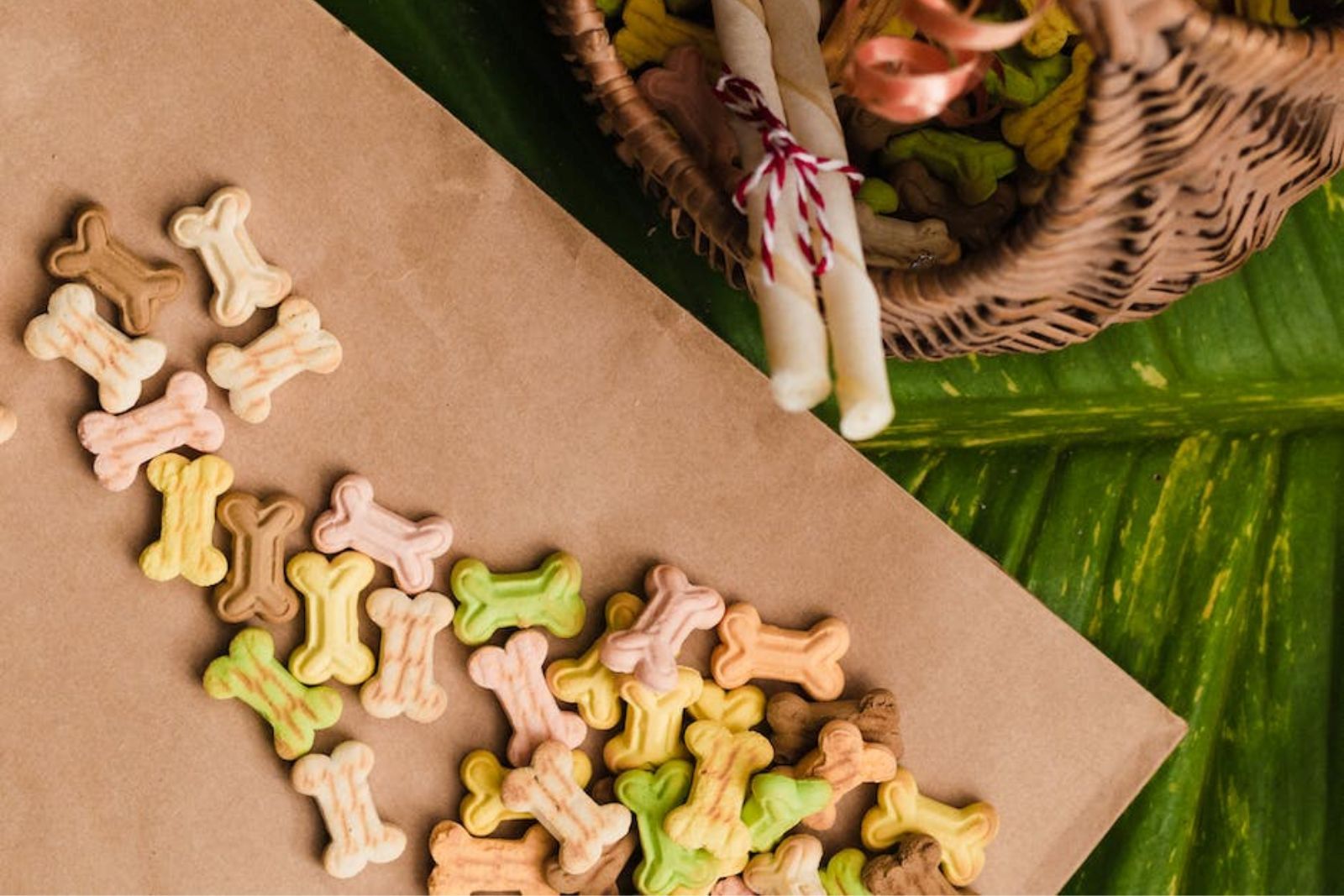
Dog treats are food items specifically made for dogs, intended to be given as rewards or snacks. They come in a variety of forms, including biscuits, chews, jerky, and dental sticks. These treats are formulated with ingredients that are safe and appropriate for canine consumption, often enriched with vitamins, minerals, and other nutrients to support dogs’ overall health and well-being.
Whether you make your own homemade treats or buy them from the store, freezing can be a convenient method to preserve their freshness and ensure you always have a stash on hand. Freezing dog treats can also be useful if you want to take advantage of bulk discounts or prepare treats in advance for special occasions. In this article, we will guide you through the process of freezing dog treats and share some tips to maintain their quality and flavor when thawed.
Here are the simple steps to freeze dog treats:
Step 1: Choose the right treats
When it comes to freezing dog treats, selecting the appropriate treats is crucial for maintaining their quality and taste after freezing. It’s important to opt for treats that have a longer shelf life and are less likely to spoil. Dry, crunchy treats or biscuits generally freeze well because their texture holds up during the freezing and thawing process. These types of treats are less prone to becoming mushy or losing their desirable texture.
On the other hand, treats with high moisture content or soft textures may not fare as well when frozen. These treats can become soggy or lose their original consistency and flavor after thawing. It’s essential to pay attention to the packaging or recipe instructions of the treats you intend to freeze. Some treats may explicitly indicate whether they are suitable for freezing or provide specific recommendations for freezing and thawing.
Can I freeze store-bought dog treats?
Yes, store-bought dog treats can be frozen following the same guidelines outlined in the article. Check the packaging of the treats for any specific freezing recommendations provided by the manufacturer. Freezing store-bought treats can be a convenient way to stock up on your pet’s favorite snacks and ensure their freshness for a longer period.
Step 2: Prepare the treats
Properly preparing the dog treats before freezing is essential to maintain their quality and prevent issues like freezer burn. One crucial step is ensuring that the treats are fully cooled to room temperature. This is especially important for homemade treats that may have just come out of the oven or been freshly prepared.
Allowing the treats to cool completely before freezing helps prevent condensation from forming inside the packaging. If warm treats are placed in the freezer, the temperature difference can cause moisture to accumulate, leading to freezer burn. Freezer burn can affect the texture and taste of the treats, making them less appealing or potentially causing them to go to waste.
To cool homemade treats, place them on a wire rack or a parchment-lined baking sheet. This allows air to circulate around the treats, aiding in the cooling process. Giving the treats enough time to cool to room temperature ensures that they are ready for freezing and minimizes the risk of moisture buildup during the freezing and storage period.
By taking the time to properly cool the treats before freezing, you can help preserve their freshness, texture, and flavor. This step contributes to ensuring that the frozen dog treats maintain their appeal and provide a delightful snack for your furry friend when thawed.
Step 3: Arrange the treats for freezing
Properly arranging the dog treats for freezing is important to ensure that they freeze individually and don’t stick together. This step helps maintain their individual shapes, prevents clumping, and allows for easier portioning when it’s time to serve them to your pup.
To arrange the treats, start by lining a baking sheet with parchment paper or a silicone mat. The non-stick surface prevents the treats from sticking to the sheet during freezing. Place the treats in a single layer on the prepared baking sheet, making sure to leave a small space between each treat.
Leaving space between the treats is crucial because it prevents them from freezing together into a solid mass. If the treats are too close, they can fuse together, making it difficult to separate them when you need to take out just a few. A little space ensures that each treat freezes individually and maintains its distinct shape and texture.
If you have a large quantity of treats, you may need to use multiple baking sheets or work in batches. This allows for optimal air circulation around each treat and ensures that they freeze evenly. It also facilitates easier handling and storage of frozen treats.
Step 4: Place the baking sheet in the freezer
After arranging the dog treats on the baking sheet, the next step is to transfer the sheet to the freezer for the treats to freeze properly. This step ensures that the treats become solid and maintain their shape during storage.
Carefully place the baking sheet with the arranged treats in the freezer. It’s important to choose a level surface in the freezer to ensure even freezing. Placing the sheet on a level surface prevents the treats from sliding or shifting, which could cause them to lose their shape or stick together.
Allow the treats to freeze in the freezer for approximately 1 to 2 hours, or until they are firm to the touch. The freezing time can vary depending on the size and thickness of the treats. Freezing them until they are firm ensures that they are solid throughout and less prone to damage or deformation during handling and storage.
What should I do if I don’t have a baking sheet for freezing dog treats?
If you don’t have a baking sheet for freezing dog treats, alternative options are available. You can use a flat plate, tray, or even a cutting board lined with parchment paper or a silicone mat. Arrange the treats in a single layer with enough space between them to prevent sticking. Once the treats are frozen, transfer them to airtight containers or freezer bags for long-term storage.
Step 5: Package the frozen treats
After the dog treats have fully frozen, it’s time to package them to ensure their long-term quality and protection from freezer burn. Proper packaging prevents moisture loss and maintains the treats’ flavor and texture during storage.
Start by removing the baking sheet with the frozen treats from the freezer. Individually wrap each treat with plastic wrap to create a barrier against air and moisture. Wrapping them individually also makes it easier to retrieve and thaw only the desired number of treats without disturbing the rest.
Alternatively, you can place the treats in airtight freezer bags. Make sure to squeeze out any excess air from the bags before sealing them tightly. Removing as much air as possible minimizes the risk of freezer burn, which can negatively affect the taste and texture of the treats over time.
For additional protection, you can place the individually wrapped treats or freezer bags inside a larger freezer-safe container or a zip-top bag. This extra layer of packaging adds insulation and further prevents freezer burn or exposure to odors in the freezer.
Proper packaging is crucial for maintaining the treats’ quality and preserving their freshness during long-term storage in the freezer. It helps prevent moisture loss, freezer burn, and the absorption of unwanted flavors. With well-packaged treats, you can ensure that they remain enticing and delicious for your furry friend when thawed and ready to be enjoyed.
Are there any alternative ways to freeze dog treats, such as ice cube trays or silicone molds?
Yes, there are alternative methods for freezing dog treats, including using ice cube trays or silicone molds. These methods can be especially useful for portioning treats or creating fun shapes for your furry friend. Simply fill the compartments of the ice cube trays or silicone molds with the treat mixture, ensuring they are compacted and level, then place them in the freezer until fully frozen. Once frozen, remove the treats from the trays or molds and transfer them to airtight containers or freezer bags for storage.
Step 6: Label and date the package
Labeling and dating the packages of frozen dog treats is a crucial step in maintaining organization and ensuring that treats are used in a timely manner. This simple practice helps you keep track of the treats in your freezer and prevents any of them from going to waste.
When labeling the package, indicate the type of treat. This information helps you quickly identify and choose the specific treat you want to thaw for your furry friend. Whether it’s “peanut butter biscuits” or “chicken jerky,” clear labeling ensures you can easily find the treat you’re looking for without having to open multiple packages.
In addition to labeling the treat type, it’s important to date the package with the freezing date. By noting the date of freezing, you establish a system of rotation, ensuring that the oldest treats are used first. This practice helps prevent treats from being forgotten or remaining in the freezer for an extended period, potentially leading to a loss of quality over time.
Labeling and dating the packages of frozen treats allows for better inventory management and reduces the chances of treats being wasted due to expiration or degradation. By using the oldest treats first, you ensure that your pup gets to enjoy them while they are still fresh and tasty.
Step 7: Freeze the treats
Once the dog treats are properly packaged and labeled, it’s time to place them in the freezer for long-term storage. Proper storage in the freezer ensures that the treats remain fresh, maintain their quality, and are ready to be enjoyed by your furry friend whenever needed.
When placing the wrapped treats in the freezer, it’s important to position them in a way that allows for proper air circulation. Avoid overcrowding or squishing the treats together, as this can lead to loss of texture or deformation. Arrange them in a single layer or stack them neatly, leaving enough space between each package.
Creating a dedicated section in the freezer for dog treats is ideal to prevent cross-contamination with other food items. This separation reduces the risk of flavors or odors from other foods transferring to the treats, ensuring their original taste and quality are preserved.
It’s also important to be mindful of the freezing temperature in the freezer. Keep the freezer at a consistent temperature, ideally set at 0°F (-18°C) or below. This ensures that the treats remain properly frozen and minimizes the risk of spoilage or freezer burn.
Remember to follow any specific storage recommendations provided by the treat manufacturer or recipe to ensure the best results. With careful freezing and storage, you can enjoy a convenient supply of delicious and nutritious dog treats for your beloved pet.
Other related questions
How long can dog treats last in the freezer?
Dog treats can last in the freezer for several months to a year, depending on the type and ingredients. Dry, crunchy treats generally have a longer freezer life, lasting up to a year when properly stored. Treats with higher moisture content or softer textures may last around 6 to 9 months. Always check for any signs of freezer burn or degradation before feeding frozen treats to your dog.
How do I defrost dog treats?
To defrost dog treats, it is best to transfer them from the freezer to the refrigerator. Allow the treats to thaw slowly in the fridge for several hours or overnight. Alternatively, you can thaw individual treats at room temperature, placing them on a plate or tray until they reach a soft and edible consistency. Avoid using a microwave or hot water to defrost dog treats, as these methods can lead to uneven thawing or alter the texture of the treats.
What is the best way to thaw frozen dog treats quickly if I forgot to take them out of the freezer in advance?
If you need to quickly thaw frozen dog treats, the best method is to place them in a sealed plastic bag and submerge the bag in cold water. Avoid using warm or hot water, as it can negatively impact the treats’ texture and safety. Monitor the treats closely during the thawing process and ensure they are fully thawed before serving them to your dog.
Should I thaw frozen dog treats before feeding them to my pet?
Thawing frozen dog treats before feeding them to your pet is not always necessary. Many dogs enjoy the texture and coolness of frozen treats, especially during hot weather. However, if your dog prefers softer treats or if the frozen texture poses a risk, you can thaw them in the refrigerator or at room temperature until they reach a desired consistency.
Can I refreeze dog treats?
It is generally not recommended to refreeze dog treats once they have been thawed. Each freeze-thaw cycle can impact the texture, taste, and quality of the treats. It is best to thaw only the amount of treats needed for immediate use to minimize waste and ensure the best flavor and texture for your furry friend.
How do I know if the dog treats have gone bad after freezing?
After freezing, dog treats can develop signs of spoilage or degradation. Some indications that frozen dog treats may have gone bad include changes in texture, such as becoming excessively dry, mushy, or crumbly. Additionally, off-putting odors, unusual colors, or the presence of mold or freezer burn are warning signs. If any of these signs are present, it is best to discard the treats to ensure the safety and well-being of your pet.
Can I freeze different types of dog treats together?
It is generally recommended to freeze different types of dog treats separately to maintain their individual flavors and prevent cross-contamination. Freezing them separately allows you to easily access and thaw specific treats without thawing the entire batch. Storing them in separate packages or compartments helps preserve their unique qualities.
Are there any specific precautions I should take when freezing dog treats with delicate or special ingredients?
When freezing dog treats with delicate or special ingredients, it is important to take certain precautions to maintain their quality. First, ensure that the treats are fully cooled before freezing to minimize condensation. Secondly, consider using extra layers of wrapping, such as plastic wrap and aluminum foil, to provide additional protection. Lastly, label the treats with detailed information about their ingredients and freezing date to keep track of their freshness and avoid any potential issues.
Can I freeze rawhide or dental chews for dogs?
Freezing rawhide or dental chews for dogs is generally not recommended. The freezing process can alter the texture and structural integrity of these chews, potentially creating a choking hazard or causing digestive issues for your dog. It is best to follow the specific instructions provided by the manufacturer for the safe and proper storage of rawhide or dental chews.
Can I freeze dog treats with icing or frosting on them?
Freezing dog treats with icing or frosting can be problematic. The freezing process can cause the icing or frosting to become soggy or lose its texture when thawed, resulting in a less appealing treat. It is advisable to avoid freezing dog treats with icing or frosting unless the specific recipe or manufacturer instructions indicate that it is safe to do so.
Are there any special considerations for freezing homemade frozen dog treats with added fruits or vegetables?
When freezing homemade dog treats with added fruits or vegetables, there are a few special considerations to keep in mind. Some fruits and vegetables have high water content, which can result in a loss of texture or make the treats too icy when frozen. Consider blanching or lightly cooking the fruits or vegetables before adding them to the treats to help preserve their quality. Additionally, it’s recommended to label the treats with the specific ingredients used and the freezing date to keep track of their freshness and ensure timely consumption.
Can I freeze dog treats with meat or fish fillings?
Freezing dog treats with meat or fish fillings is generally safe and can be a convenient way to store them for longer periods. However, it is important to consider the ingredients used and the overall quality of the treats. Ensure that the meat or fish used is fresh and of good quality, and avoid freezing treats that have been previously thawed or stored for an extended time. Proper packagings, such as airtight containers or individual wrapping, will help maintain the treats’ flavor and prevent freezer burn.
Can I freeze dehydrated or freeze-dried dog treats?
Yes, you can freeze dehydrated or freeze-dried dog treats. These types of treats are already preserved through the dehydration or freeze-drying process, which removes moisture and extends their shelf life. Freezing them can provide an additional layer of protection and help maintain their freshness. Simply place the dehydrated or freeze-dried treats in airtight containers or freezer bags before storing them in the freezer.








